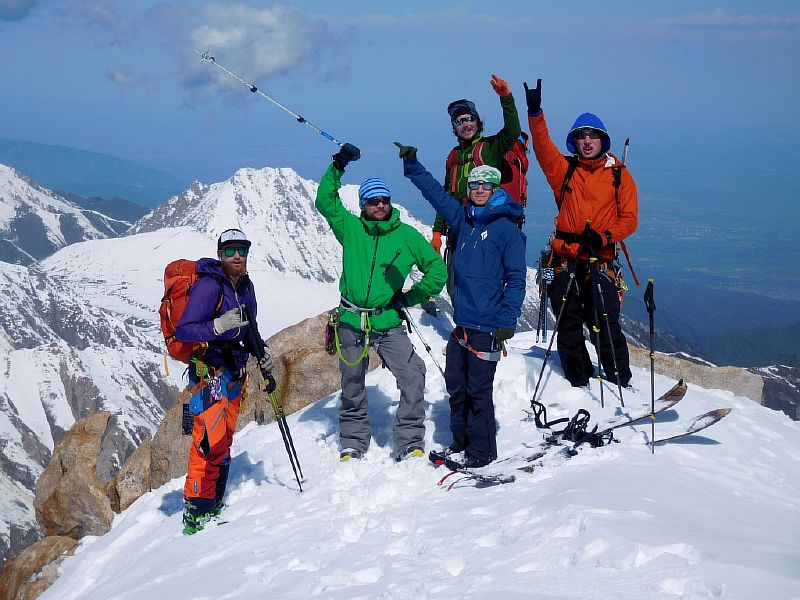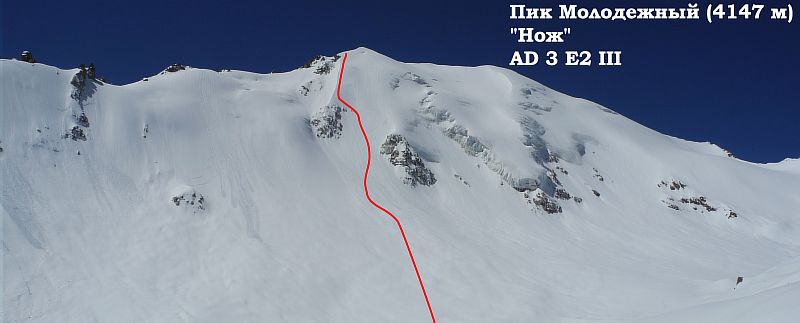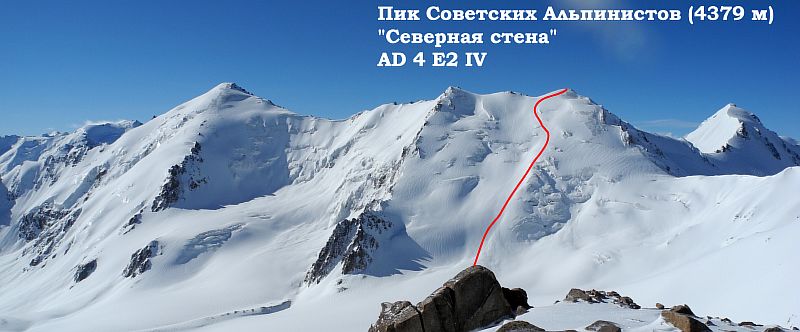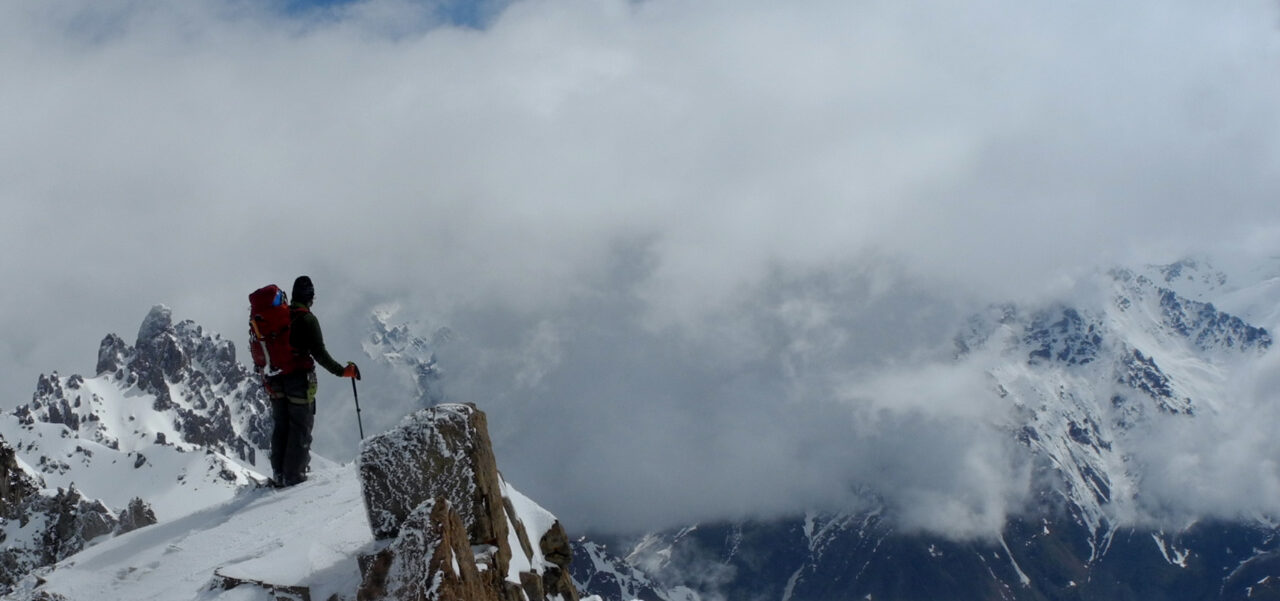Author: Sergey Ichenets, WildGuru guide.
The winter season in the Big Gudauri pleased us with good snow and new lines, but we try to lack something special, new. This rides we found in Kazakhstan. Our team was: WildGuru guides — Ichenets Sergei, Dmitry Mikhailov, Bartosh Constantine; RMGA guide Zaharin Victor; our friends Andrei Gusarov and Yauhen Vilyuzhanin.

The Zailiiskii Alatau is a part of the Tien Shan mountain range. The highest point — peak Talgar (4979 m above sea level). Spring 2016 was abnormal in all respects. «It happens once in 20 years» — a capacious and exhaustive commentary from local meteorologists. The amount of precipitation was tremendous. While the city was flooded by rain, there were heavy snowfalls in the mountains. 2-4 meter layer of snow was covering glaciers.

The month of May and Almaty is already in full swing summer. Street markets are full of cherries and strawberries. The city daytime temperatures of + 25 °C, the children are swimming in the local fountains. However, you just need to raise your head a bit and the view of the huge snow-capped mountain peaks will appear before your eyes. Ours waylaid exactly there.

A few words about the skiing region
Tuyuk-Su region is a large horseshoe-like valley with 4100-4400 meters high peaks. The steep snow and ice slopes, narrow couloirs, complex rock terrain. Winter in this mountain range is cold and with little snowfalls, plus all is accompanied by strong winds, that becomes much lighter in spring. This season is rich in precipitation, and as a result — the slopes are covered with winter-like condition snow. May is a paradise for ski touring and ski mountaineering.

Planning ski tour trips
We decided to divide our two-week stay into two stages.
First: one-day ski-tour-outs in the region of Tuyuk-Su glacier. A great opportunity to acclimatize, get back into the skiing stream, and try to make some new lines in the region.
The second stage– a serious multi-day ski tour with tents for the exploration of the new opportunities in the region and making first descents.
Part I. 14-20 May 2016
Our trip to the base cam was successful. The amount and quality of snow were more than satisfactory. The first few days we have dedicated to relatively simple lines to be drawn into skitour at these altitudes and get used to the snow. After riding, the entire team actively trained in emergency rope skills. Looking ahead, I will say that fortunately these skills were left unused. Every day we were gaining momentum. All the lines are complex — mostly steep ice slopes of 35-40°. Separate steep sections of up to 50°, requiring exceptional skiing and snowboarding skills. Rocks often limit the ski area on the sides. You should choose your descent line carefully — the wrong line can lead to injuries and falls from icefalls.
At this stage of our adventure we made the following first descents:
- Pogrebetskogo peak (D 4 E3 III);
- Molodejniy peak (D 4 E2 III).
In addition, paid a visit to these classic lines:
- Tuyk-Su peak (Shovel) (D 4 E3 III);
- Tuyk-Su shoulder (AD- 3 E2 III);
- Pogrebetskogo peak (AD+ 4 E3 III);
- Orjonikidze (AD- 3 E2 III);
- Tuyk-Su Pass (AD- 3 E2 III);
- FWT Ridge (PD+ 3 E2 II).



Our morning often started around 4:00, and at 5:00 we were usually already on the route. The average daily ski touring time is about 4-5 hours (depends on snow conditions). From 12:00 «day» ended – the risk of avalanches increases dramatically, and the quality of the snow on the lower parts of the slopes dropped sharply. We preferred to sunbathe in the camp during the daytime, have a rest, and plan the following skiing days. In past years, the snow quality was much worse, and many areas were only accessible on crampons. This year during the first week almost everywhere was great snow, suitable for walking on skis. Almost every new portion of powder dumped on us, and skiing was a pleasure. Especially memorable was the day of May 18, 2016, when the glaciers received more than 40cm of real winter snow.

The main part of our May backcountry waited for us.

A week of active load at heights of over 3,500 m is a serious test for the organism. Every day early starts (4-5 am), serious climbs, exercise, lack of shower and normal drinking water gradually sucked our strength. Therefore, before a second, more difficult part, it was decided to go down to Almaty for a few days in order to relax a little, gain strength, and to purchase food.

Part II. 23-31 May 2016
Our short relaxation ended. It is time to get back to the mountains. Familiar trail and heavy rain were the best motivation to climb to the camp as soon as possible. At 3000 m rain gave way to snow and our sneakers were replaced by boots and skis.
The following morning we were on the way to the Molodezhniy peak, where unknown land began. The descent on the backside of the mountain on firn (AD 3 E2 III), a bit of ski tour, a bit of climbing in crampons — and we are on the ridge. There we chose a safe place to spend the night and aligned the platform for the tent. The sky gradually clouded, and we fell asleep with the sound of falling snow and thunder. Access to the route is scheduled for 6 am.

First descent from the peak of Soviets (4317m)
In the sun and completely calm sky, step by step we are gaining altitude and achieve the peak of the Soviets. That’s the top. After a short preparation, Dmitry Mikhailov goes first, then all other members of the team. Below us lies great snow, though a bit wet, but it does not interfere with our descent. A layer of snow on the glacier is about 2 meters, which means that the crevasses are securely covered. Teamwork, favorable weather conditions — downhill was superb! Shortly after, we stand below and look at the lines left on the mountain.
It was the First descent line on the glacier of the northeast wall of the Soviets peak.

We rejoiced successful descent, but it was too early to relax: it is necessary to climb to the pass, collect tents, and move on as soon as possible.
Ahead of us lies a new pass and the new mountain — the peak of Soviet climbers.
***
We sat in the tent. Wind walls protected us from heavy snowfall. We dug in notably: our temporary shelters have gone below snow level for more than a meter. The bad weather began yesterday afternoon, in an hour after the descent from the peak of the Soviets. During the ascent to the pass of Tourists, it became even worse: it began to snow and the wind force increased. We were locked up at the height of 4000 meters for a day. Time began to flow really slow, and we appreciated every little occupation imaginable. We had food exactly for one day, so either we start ascent tomorrow or set back until the next year.

And the weather gave us a fat chance!
First descent line from the peak of Soviet climbers (4379 m)
5:00. The sky is partly cloudy, and the forecast seems not so promising. Skitour and hiking parts of the route were easy, and we came to the rocks. It is time for climbing. We had to climb two pitches, finding good places for anchors.

It took us an hour, but time today was of the essence that day. The weather was not perfect and began getting even worse. The sky is overcast with dense clouds, it started snowing. Waiting for a weather window at the height is compromising — there is a risk not to go down at all. We almost lost hope and decided to go down by ascension path, but suddenly the weather starts to give us light. From time to time snow stopped and you could see the blue sky in the distance. Therefore, we still decide to go on with the initially planned line. Victor skis the first 50 meters on the belay: a dangerous steep part that bends into zero visibility. Snow behaves consistently. Shortly after, we begin our descent one by one with occasional stops in order to wait for the appropriate visibility. Snow conditions are simply amazing – winter is not ending. The steepness of the slope is about 40°.

Already at the bottom, at the foot of the glacier, we begin to realize that we have done it and can safely return.

Wet snow sprays fly from under the edges. After a few turns, the snow line ends. Green grass and summer await us ahead. The date was May 30.
Results:
- First descent line on the glacier of the north-east wall of the Soviets peak. Difficulty: AD 4 E2 IV on the European classification.
- First descent line with the peak of Soviet climbers. Difficulty: AD 4 E2 IV on the European classification. It was the first ride ever from that peak.
The team deserves special words of gratitude. Excellent preparation, plenty of experience, and the coherence of the entire group allowed us to do ascensions that we wouldn’t be able to do separately. Thanks, guys!
***
In conclusion, I want to say that the region has great potential for skitour and ski mountaineering, however, the region’s requirements for the skiers and snowboarders are serious: you need a high level of skiing/snowboarding, to have a good theoretical and technical base (avalanche safety, mountaineering skills, organization of rescue operations, etc.). Huge snow-ice fields with slopes up to 50°, narrow technical couloirs, complex lines among seracs and icefalls — this is the Tuyuk-Su region. A huge number of lines are still waiting for their riders. The snow cover, weather, and the condition of the glaciers make May a great period to ride here. The relative proximity of civilization and the opportunity to stay in the camp — a very good choice for riders who want to try new complex lines, but to make it as comfortable as possible. We will certainly come back here next year with new ideas and plans!


